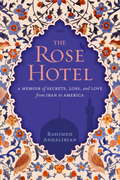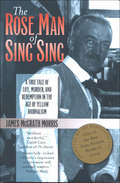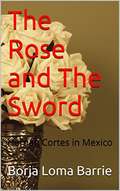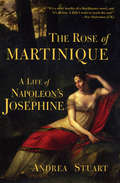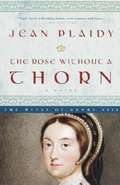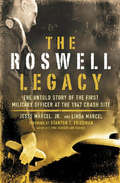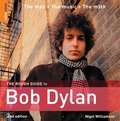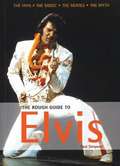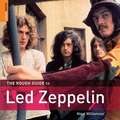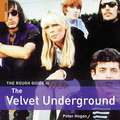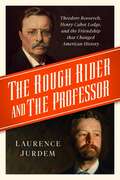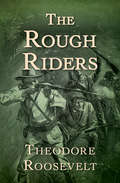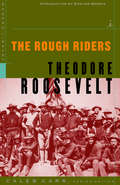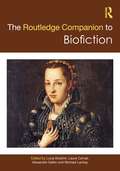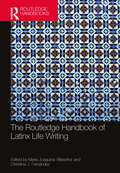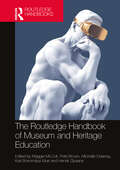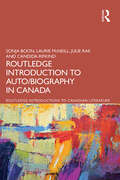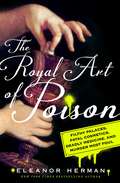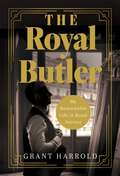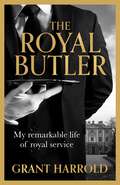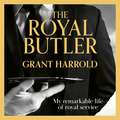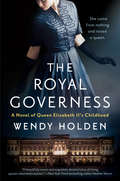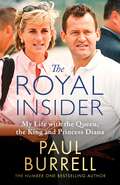- Table View
- List View
The Rose Hotel
by Rahimeh AndalibianIn this searing memoir, Iranian-born author Rahimeh Andalibian tells the story of her family: how they survived the 1979 revolution; their move to California; and their attempts to adapt in the face of addiction, teenage rebellion, and new traditions. Andalibian struggles to make sense of two brutal crimes: a rape, avenged by her father, and a murder, of which her beloved oldest brother stands accused. She takes us first into her family's tranquil, jasmine-scented days of prosperity in Mashhad, Iran, where she and her brothers grow up in luxury at the Rose Hotel, owned by her father. In the aftermath of the 1979 revolution the family is forced to flee: first to the safety of a mansion in Tehran, next to a squalid one-room flat in London, and finally to California, where they discover they are not free from the weight of their own secrets. Caught between their parents' traditional values and their desire to embrace an American way of life, Andalibian and her brothers struggle to find peace in the wake of tragedy. Eloquently and intimately told, The Rose Hotel is a universal story of healing and rebirth.
The Rose Man of Sing Sing: A True Tale of Life, Murder, and Redemption in the Age of Yellow Journalism (Communications and Media Studies #No. 8)
by James M. MorrisToday, seventy-three years after his death, journalists still tell tales of Charles E. Chapin. As city editor of Pulitzer’s New York Evening World , Chapin was the model of the take-no-prisoners newsroom tyrant: he drove reporters relentlessly—and kept his paper in the center ring of the circus of big-city journalism. From the Harry K. Thaw trial to the sinking of the Titanic , Chapin set the pace for the evening press, the CNN of the pre-electronic world of journalism. In 1918, at the pinnacle of fame, Chapin’s world collapsed. Facing financial ruin, sunk in depression, he decided to kill himself and his beloved wife Nellie. On a quiet September morning, he took not his own life, but Nellie’s, shooting her as she slept. After his trial—and one hell of a story for the World’s competitors—he was sentenced to life in the infamous Sing Sing Prison in Ossining, New York. In this story of an extraordinary life set in the most thrilling epoch of American journalism, James McGrath Morris tracks Chapin’s rise from legendary Chicago street reporter to celebrity powerbroker in media-mad New York. His was a human tragedy played out in the sensational stories of tabloids and broadsheets. But it’s also an epic of redemption: in prison, Chapin started a newspaper to fight for prisoner rights, wrote a best-selling autobiography, had two long-distance love affairs, and tapped his prodigious talents to transform barren prison plots into world-famous rose gardens before dying peacefully in his cell in 1930. The first portrait of one of the founding figures of modern American journalism, and a vibrant chronicle of the cutthroat culture of scoops and scandals, The Rose Man of Sing Sing is also a hidden history of New York at its most colorful and passionate.James McGrath Morris is a former journalist, author of Jailhouse Journalism: The Fourth Estate Behind Bars , and a historian. He lives in Falls Church, Virginia, and teaches at West Springfield High School.
The Rose and the Sword. Hernan Cortes in Mexico
by Borja Loma Barrie Sofia ChavezThis book is a compilation of Hernan Cortes's journey through life and the venture that would change his entire life and the destiny of a new continent. A story about an adventurous spirit and a very determined mind that changed the faith of a nation thanks to a man's ambition who decided the world was not big enough for him.
The Rose of Martinique: A Life of Napoleon's Josephine
by Andrea Stuartbiography of Napoleon's empress, using many primary sources and containing much about her life before her famous second marriage.
The Rose of Martinique: A Life of Napoleon's Josephine
by Andrea StuartOne of the most remarkable women of the modern era, Josephine Bonaparte was born Rose de Tasher on her family's sugar plantation in Martinique. She embodied all the characteristics of a true Creole-sensuality, vivacity, and willfulness. Using diaries and letters, Andrea Stuart expertly re-creates Josephine's whirlwind of a life, which began with an isolated Caribbean childhood and led to a marriage that would usher her onto the world stage and crown her empress of France.Josephine managed to be in the forefront of every important episode of her era's turbulent history: from the rise of the West Indian slave plantations that bankrolled Europe's rapid economic development, to the decaying of the ancien régime, to the French Revolution itself, from which she barely escaped the guillotine.Rescued from near starvation, she grew to epitomize the wild decadence of post-revolutionary Paris. It was there that Josephine first caught the eye of Napoleon Bonaparte. A true partner to Napoleon, she was equal parts political adviser, hostess par excellence, confidante, and passionate lover. In this captivating biography, Stuart brings her so utterly to life that we finally understand why Napoleon's last word before dying was the name he had given her: Josephine.
The Rose without a Thorn: A Novel (The Queens of England, Volume #11)
by Jean PlaidyFrom the pen of legendary historical novelist Jean Plaidy comes an unforgettable true story of royalty, passion, and innocence lost. Born into an impoverished branch of the noble Howard family, young Katherine is plucked from her home to live with her grandmother, the Duchess of Norfolk. The innocent girl quickly learns that her grandmother's puritanism is not shared by Katherine's free-spirited cousins, with whom she lives. Beautiful and impressionable, Katherine becomes involved in two ill-fated love affairs before her sixteenth birthday. Like her cousin Anne Boleyn, she leaves her grandmother's home to become a lady-in-waiting at the court of Henry VIII. The royal palaces are exciting to a young girl from the country, and Katherine finds that her duties there allow her to be near her handsome cousin, Thomas Culpepper, whom she has loved since childhood. But when Katherine catches the eye of the aging and unhappily married king, she is forced to abandon her plans for a life with Thomas and marry King Henry. Overwhelmed by the change in her fortunes, bewildered and flattered by the adoration of her husband, Katherine is dazzled by the royal life. But her bliss is short-lived as rumors of her wayward past come back to haunt her, and Katherine's destiny takes another, deadly, turn.
The Roswell Legacy: The Untold Story of the First Military Officer at the 1947 Crash Site
by Jesse Marcel Jr. Linda MarcelA behind-the-scenes memoir recounting one officer&’s firsthand experience of America&’s most famous UFO incident. Does extraterrestrial life exist? Have alien beings actually visited Earth and left clear traces of their visits? One man has the answer...and his son can now break the silence. The Roswell Legacy is the story of Major Jesse Marcel, the intelligence officer for the 509th Bomber Group—famous for dropping the atomic bomb on Japan—and the first military officer to reach the scene of one of the most famous and enduring UFO events in the recorded history of mankind. This book documents the recovery of debris from the crash of an extraterrestrial craft and how the Marcel family became forever linked to the event. It details what the debris looked like, how it greatly differed from that of the &“weather balloon&” that was supposedly recovered, and the physical characteristics that prove it could have come only from a technology that was not available in the 1940s—or, perhaps, even now.
The Rough Guide to Bob Dylan
by Nigel WilliamsonBob Dylan is the ultimate singer-songwriter - revered, enigmatic and responsible for a staggering number of classic songs. This second edition of The Rough Guide to Bob Dylan demystifies the man and the music, exploring his life, his lyrics, and the legends that surrounded them. The Life: from Minnesota to Manchester, from the Albert Hall to the Never Ending Tour, The Music: the 50 greatest songs and the stories behind them, plus albums, bootlegs and compilations, The Movies: Dylan on screen and soundtracks, from Pat Garrett & Billy the Kid to No Direction Home, Dylanology: the wisdom of Bob, comic songs and curios, plus books, fanzines and websites.
The Rough Guide to Elvis
by Paul SimpsonJanuary 2005 was the 70th anniversary of Elvis Presley's birth. This new edition of the Rough Guide to Elvis is the most up-to-date guide on every aspect of The King, from his songs to his record collection, his cars to his costumes, from his birth to his mythic afterlife. The guide charts his life, the music, the 50 essential Presley songs, the collectables, the museums, a world tour of the essential Elvis sights - from Graceland to Germany - and the Icon - Elvis as king, star, image and myth.
The Rough Guide to Led Zeppelin
by Nigel WilliamsonRock legends Led Zeppelin remain a colossal music force with songs at once mystical, heavy, traditional and highly original. The Rough Guide to Led Zeppelin tells the story of the life and afterlife of this most extraordinary supergroup. Features include: The Story: from the first meeting of Plant and Page to the untimely death of John Bonham, detailing the magic, mayhem and excesses of the era. The Music: the band's fifty best songs unpicked, plus coverage of blues influences, bootlegs, solo careers, and the best Jimmy Page guitar solos and most outstanding Robert Plant vocals. The Passengers: profiles of collaborators and colleagues including Roy Harper and Mickie Most. The Cargo: Zeppelin films, places, myths and memorabilia, books, websites and the afterlife of 'Stairway to Heaven.' It's a whole lotta Zep . . . .
The Rough Guide to the Velvet Underground
by Peter HoganSporting shades and a feedback-heavy sounds, the Velvets straddled art and rock, changing popular music forever, and sowing the seeds for punk, grunge and thousands of counter-cultural four-chord wonders. The Rough Guide to The Velvet Underground explores: The Velvet Story: How Lou Reed, Sterling Morrison, John Cale and the others emerged from the New York scene, their successes and excesses and what happened to each in their solo years. Velvet Music: From their 1967 debut with Nico to their 1993 reunion with all the tales behind the tunes. Velvet Universe: Everybody who was anybody in the Velvet's world, taking in Andy Warhol, Edie Sedgwick, David Bowie, Delmore, Schwaretsz and Brian Eno. Velvet Goldmine: The Underground on screen, the Velvet's New York, clubs, influences, covers, websites and more.
The Rough Rider and the Professor: Theodore Roosevelt, Henry Cabot Lodge, and the Friendship that Changed American History
by Laurence JurdemEvoking the political intrigue of the Gilded Age, The Rough Rider and the Professor chronicles the extraordinary thirty-five-year friendship between President Theodore Roosevelt and Senator Henry Cabot Lodge of Massachusetts.Theodore Roosevelt was a uniquely gifted figure. A man of great intellect and physicality, the New York patrician captured the imagination of the American people with his engaging personality and determination to give all citizens regardless of race, color, or creed the opportunity to achieve the American dream. While Roosevelt employed his abilities to rise from unknown New York legislator to become the youngest man ever to assume the presidency in 1901, that rapid success would not have occurred without the assistance of the powerful New Englander, Henry Cabot Lodge. Eight years older than Roosevelt, from a prominent Massachusetts family, Lodge, was one of the most calculating, combative politicians of his age. From 1884 to 1919 Lodge and Roosevelt encouraged one another to mine the greatness that lay within each of them. As both men climbed the ladders of power, Lodge, focused on dominating the political landscape of Massachusetts, served as the future president&’s confidant and mentor, advising him on political strategy while helping him obtain positions in government that would eventually lead to the White House. Despite the love and respect that existed between the two men, their relationship eventually came under strain. Following Roosevelt's ascension to the presidency, T. R.&’s desire to expand the social safety net—while attempting to broaden the appeal of the Republican Party—clashed with his older friend's more conservative, partisan point of view. Those tensions finally culminated in 1912. Lodge's refusal to support the former president's independent bid for a third presidential term led to a political break-up that was only repaired by each man's hatred for the policies of Woodrow Wilson. Despite their political disagreements, Theodore Roosevelt and Henry Cabot Lodge remained devoted friends until the Rough Rider took his final breath on January 6, 1919.
The Rough Riders
by Theodore RooseveltTheodore Roosevelt’s bestselling memoir chronicling the 1st United States Volunteer Cavalry and its victory at San Juan Hill in the Spanish-American War. Yearning to join the fight for Cuban independence in the Spanish–American War, Theodore Roosevelt and Col. Leonard Wood formed the 1st United States Volunteer Cavalry. They enlisted a motley crew from all walks of life, from cowboys and frontiersmen to Ivy League graduates. These 1,250 men became known as the Rough Riders. After training in San Antonio, Texas, they set out for the tropical jungles of Cuba. As they grappled with hunger, malaria, and occasional defeat, their many battles with the Spanish Army culminated in the death-defying charge to victory at San Juan Hill. Through it all, Roosevelt kept a pocket diary in which he made daily entries about his experiences and the men who fought beside him. Imbued with his trademark vigor and certainty of purpose, Roosevelt’s firsthand account of this historic campaign paints a vivid picture of the rugged, independent spirit that came to define American heroism. This ebook has been professionally proofread to ensure accuracy and readability on all devices.
The Rough Riders: An Account Of The Experiences And Hardships Of The American Rough Riders (Modern Library War)
by Theodore RooseveltIn 1898, as the Spanish-American War was escalating, Theodore Roosevelt assembled an improbable regiment of Ivy Leaguers, cowboys, Native Americans, African-Americans, and Western Territory land speculators. This group of men, which became known as the Rough Riders, trained for four weeks in the Texas desert and then set sail for Cuba. Over the course of the summer, Roosevelt's Rough Riders fought valiantly, and sometimes recklessly, in the Cuban foothills, incurring casualties at a far greater rate than the Spanish. Roosevelt kept a detailed diary from the time he left Washington until his triumphant return from Cuba later that year. The Rough Riders was published to instant acclaim in 1899.Robust in its style and mesmerizing in its account of battle, it is exhilarating, illuminating, and utterly essential reading for every armchair historian and at-home general. The books in the Modern Library War series have been chosen by series editor Caleb Carr according to the significance of their subject matter, their contribution to the field of military history, and their literary merit.
The Routledge Companion to Biofiction (Routledge Literature Companions)
by Michael Lackey Lucia Boldrini Alexandre Gefen Laura CernatThe Routledge Companion to Biofiction provides readers with the history, origins, and evolution of this popular genre. Featuring contributions from leading scholars in the field, this authoritative collection foregrounds analyses of biofiction's core foundations through contemporary debates. The volume is organized into seven sections: Histories of biofiction; Theoretical reflections on biofiction; Biofiction, national models and (trans)national constructions; Biofiction as political intervention; Biofictional case studies; Activating lives: early modern women; and Authorial reflections. This groundbreaking collection features works that refine our understanding of the genesis and evolution of biofiction; theorize its unique and distinctive modes of signifying; reflect on its value for the future and social justice; chart new approaches for doing biofictional analysis; and offer insights from authors of biofiction into the creative process.This is the first collection to bring together the two main schools of interpreting biofiction – the Francophone and Anglophone – while also shedding light on biofictions in many languages, from or about many continents, and offering a platform to established and new voices alike. It will be essential reading for students as well as advanced scholars interested in biographical fiction.
The Routledge Handbook of Latinx Life Writing (Routledge Literature Handbooks)
by Maria Joaquina VillaseñorThe Routledge Handbook of Latinx Life Writing provides an in‑depth introduction to Latinx life writing, taking a historical approach to the study of a variety of key Latinx life writers, genres, and thematic concerns. This volume includes chapters on fundamental genres of Latinx life writing including memoir, autobiography, oral history, testimonio, comics and graphic texts, poetry of protest, and theatre to more fully depict the breadth, dynamism, and vibrancy of Latinx life writing. Latinx people continuously engaged in the empowering act of telling their stories and narrating their lives, producing writing that at various times and in various ways expressed their joy, expressed their rage and anguish, and ultimately, asserted their subjectivity all the while indelibly contributing to the American literary landscape.
The Routledge Handbook of Museum and Heritage Education (Routledge Handbooks on Museums, Galleries and Heritage)
by Michelle Delaney Pete Brown Maggie McColl Karl Borromäus Murr Henrik ZipsaneThe Routledge Handbook of Museum and Heritage Education is a practical reference guide that shows how museums, galleries and heritage sites can offer opportunities for successful visitor engagement.Defining museums as all cultural sites that interpret collections and spaces for public education, understanding, and enjoyment, this volume argues that museum education has a central role in the development of policies, practices, and research for engagement. Including contributions from experts across the globe, the volume shows how these sites can continue to offer unique opportunities for social, physical, emotional, and academic engagement that are much needed to inform and empower museum visitors internationally. It also demonstrates how museums, galleries, and heritage sites can be utilised for the betterment and sustainability of our world and the societies we live in. Combining rich theory with innovative practice, this book provides a comprehensive analysis of museum and heritage education today.The Routledge Handbook of Museum and Heritage Education will be of interest to academics, students, and professionals who are based in the fields of museum education, heritage, adult and community education, cultural studies, social studies, psychology, and tourism.
The Routledge Introduction to Auto/biography in Canada (Routledge Introductions to Canadian Literature)
by Julie Rak Candida Rifkind Sonja Boon Laurie McNeillThe Routledge Introduction to Auto/biography in Canada explores the exciting world of nonfiction writing about the self, designed to give teachers and students the tools they need to study both canonical and lesser-known works. The volume introduces important texts and contexts for interpreting life narratives, demonstrates the conceptual tools necessary to understand what life narratives are and how they work, and offers an historical overview of key moments in Canadian auto/biography. Not sure what life writing in Canada is, or how to study it? This critical introduction covers the tools and approaches you require in order to undertake your own interpretation of life writing texts. You will encounter nonfictional writing about individual lives and experiences—including biography, autobiography, letters, diaries, comics, poetry, plays, and memoirs. The volume includes case studies to provide examples of how to study and research life narratives and toolkits to help you apply what you learn. The Routledge Introduction to Auto/biography in Canada provides instructors and students with the contexts and the critical tools to discover the power of life writing, and the skills to study any kind of nonfiction, from Canada and around the world.
The Royal Art of Poison: Filthy Palaces, Fatal Cosmetics, Deadly Medicine, and Murder Most Foul
by Eleanor Herman"You’ll be as appalled at times as you are entertained." —Bustle, one of The 17 Best Nonfiction Books Coming Out In June 2018"A heady mix of erudite history and delicious gossip." —Aja Raden, author of StonedIn the Washington Post roundup, "What your favorite authors are reading this summer," A.J. Finn says, “I want to read The Royal Art of Poison, Eleanor Herman’s history of poisons."Hugely entertaining, a work of pop history that traces the use of poison as a political—and cosmetic—tool in the royal courts of Western Europe from the Middle Ages to the Kremlin todayThe story of poison is the story of power. For centuries, royal families have feared the gut-roiling, vomit-inducing agony of a little something added to their food or wine by an enemy. To avoid poison, they depended on tasters, unicorn horns, and antidotes tested on condemned prisoners. Servants licked the royal family’s spoons, tried on their underpants and tested their chamber pots. Ironically, royals terrified of poison were unknowingly poisoning themselves daily with their cosmetics, medications, and filthy living conditions. Women wore makeup made with mercury and lead. Men rubbed turds on their bald spots. Physicians prescribed mercury enemas, arsenic skin cream, drinks of lead filings, and potions of human fat and skull, fresh from the executioner. The most gorgeous palaces were little better than filthy latrines. Gazing at gorgeous portraits of centuries past, we don’t see what lies beneath the royal robes and the stench of unwashed bodies; the lice feasting on private parts; and worms nesting in the intestines. In The Royal Art of Poison, Eleanor Herman combines her unique access to royal archives with cutting-edge forensic discoveries to tell the true story of Europe’s glittering palaces: one of medical bafflement, poisonous cosmetics, ever-present excrement, festering natural illness, and, sometimes, murder.
The Royal Butler: My Remarkable Life in Royal Service
by Grant HarroldAn unforgettable portrait of the royal household, told by the former butler to King Charles III.Grant Harrold had been obsessed with the royaly family since childhood. In this unforgettable memoir, we journey along with Grant as he finds his way to the heart of the royal household. The unique relationship between the monarch and their staff has always been shrouded in mystery but The Royal Butler artfully reveals never before heard stories about his time in royal service. Today, Grant Harrold is a leading expert on etiquette, and in The Royal Butler he draws on his time as a member of the royal household of Their Majesties King Charles III and Queen Camilla. Based at their country Highgrove House in the Cotswolds, his duties included being butler for the king and queen, the Prince and Princess of Wales and the Duke of Sussex. On occasions, Grant also had the honour to Butler for the Late Queen Elizabeth II and her Husband The Late Prince Philip Duke of Edinburgh. The Royal Butler brings to life the extraordinary world of the Windsors as never before.
The Royal Butler: My remarkable life of royal service
by Grant HarroldDiscover the revelatory royal autobiography of the year, with stories featuring Queen Elizabeth II, King Charles III and many more.From an early age, Grant Harrold was always obsessed with the royal family. Glued to the television screen watching countless documentaries on Her Majesty the Queen, it seemed the most unlikely outcome that this working-class boy from Scotland would end up walking the corridors of royal palaces and households. Starting out as a young and naive under-butler in stately homes and working his way up to the highest honour of serving the King and Queen, this memoir charts Grant's extraordinary journey to the highest levels of royal society.The relationship between the king and his staff has always been shrouded in mystery, but in this compelling autobiography, one of Britain's top royal experts reveals his story for the first time and shares insight and never-before-heard stories about his time in royal service.
The Royal Butler: My remarkable life of royal service
by Grant HarroldDiscover the revelatory royal autobiography of the year, with stories featuring Queen Elizabeth II, King Charles III and many more.From an early age, Grant Harrold was always obsessed with the royal family. Glued to the television screen watching countless documentaries on Her Majesty the Queen, it seemed the most unlikely outcome that this working-class boy from Scotland would end up walking the corridors of royal palaces and households. Starting out as a young and naive under-butler in stately homes and working his way up to the highest honour of serving the King and Queen, this memoir charts Grant's extraordinary journey to the highest levels of royal society.The relationship between the king and his staff has always been shrouded in mystery, but in this compelling autobiography, one of Britain's top royal experts reveals his story for the first time and shares insight and never-before-heard stories about his time in royal service.
The Royal Butler: My remarkable life of royal service
by Grant HarroldDiscover the revelatory royal autobiography of the year, with stories featuring Queen Elizabeth II, King Charles III and many more.From an early age, Grant Harrold was always obsessed with the royal family. Glued to the television screen watching countless documentaries on Her Majesty the Queen, it seemed the most unlikely outcome that this working-class boy from Scotland would end up walking the corridors of royal palaces and households. Starting out as a young and naive under-butler in stately homes and working his way up to the highest honour of serving the King and Queen, this memoir charts Grant's extraordinary journey to the highest levels of royal society.The relationship between the king and his staff has always been shrouded in mystery, but in this compelling autobiography, one of Britain's top royal experts reveals his story for the first time and shares insight and never-before-heard stories about his time in royal service.
The Royal Governess: A Novel of Queen Elizabeth II's Childhood
by Wendy HoldenIn "a beautifully woven and exquisitely detailed story of strong upstairs/downstairs women&” (Heather Morris, New York Times bestselling author of The Tattooist of Auschwitz) Sunday Times bestselling author Wendy Holden brings to life the unknown childhood years of one of the world&’s most famous figures, Queen Elizabeth II, and reveals the spirited young governess who made her the icon we love today. In 1933, twenty-two-year-old Marion Crawford accepts the role of a lifetime, tutoring the little Princesses Elizabeth and Margaret Rose. Her one stipulation to their parents the Duke and Duchess of York is that she bring some doses of normalcy into their sheltered and privileged lives. At Buckingham Palace, Windsor Castle and Balmoral, Marion defies stuffy protocol to take the princesses on tube trains, swimming at public baths, and on joyful Christmas shopping trips at Woolworth&’s. From her ringside seat at the heart of the British monarchy she witnesses twentieth-century history&’s most seismic events. The trauma of the Abdication, the glamour of the Coronation, the onset of World War II. She steers the little girls through it all, as close as a mother. During Britain&’s darkest hour, as Hitler&’s planes fly over Windsor, she shelters her charges in the castle dungeons (not far from where the Crown Jewels are hidden in a biscuit tin). Afterwards, she is present when Elizabeth first sets eyes on Philip. But being beloved confidante to the Windsors comes at huge personal cost. Marriage, children, her own views: all are compromised by proximity to royal glory. In this majestic story of love, sacrifice and allegiance, bestselling novelist Holden shines a captivating light into the years before Queen Elizabeth II took the throne.
The Royal Insider: My Life with the Queen, the King and Princess Diana
by Paul BurrellTHE BRAND NEW REVELATORY ROYAL MEMOIR FROM THE SUNDAY TIMES AND NEW YORK TIMES BESTSELLING AUTHOR PAUL BURRELL.'For twenty-one years I was in a privileged position and shared the lives of the Queen and Princess Diana. Now that neither of these two wonderful women are here, that duty continues for me in the need to protect their legacy.'For over two decades, Paul Burrell was a silent witness to the making of history - first as footman to Queen Elizabeth II, then as butler to King Charles III (then Prince of Wales), and, most famously, as a confidante of the late Princess Diana. Now, with a unique perspective shaped by time and change, he's ready to share his own story alongside theirs. His bestselling memoir, A Royal Duty, about his friendship with Diana, sent shockwaves around the world, selling over two million copies. But it is only, in the wake of the Queen's passing and the commencement of a new royal era, Burrell feels he can finally tell his story in full. In this deeply personal and intimate memoir, Burrell shares many untold stories of his life at home and abroad with the Royals. With warmth, candour, and rare insight, he recounts unexpected moments of intimacy with the Queen, who gently guided a fresh-faced, 18-year-old Burrell through palace life. He speaks candidly about the tensions that simmered during those years - including the breakdown of Charles and Diana's marriage and his own complex relationship with Princes William and Harry. He also reveals his heartache at parting with three of the most significant women in his life - the Queen, Diana and his wife Maria - all while navigating his own personal journey to happiness as well as a battle with prostate cancer. Heartfelt, sincere and rich in detail, this is the memoir of a man who has lived and learned in the most extraordinary of ways.
